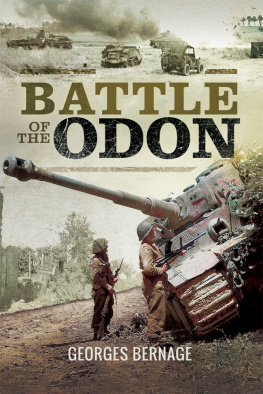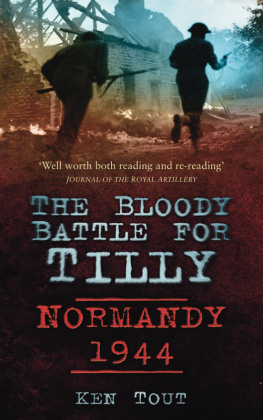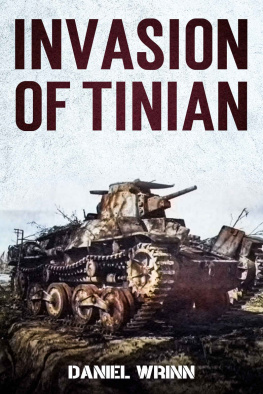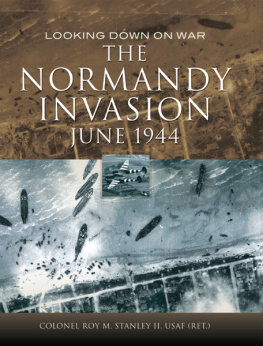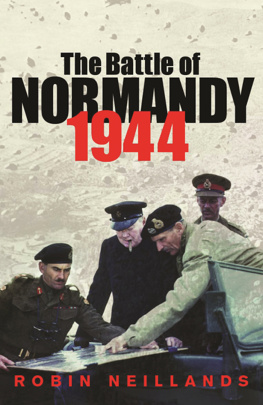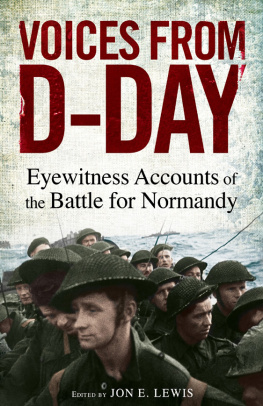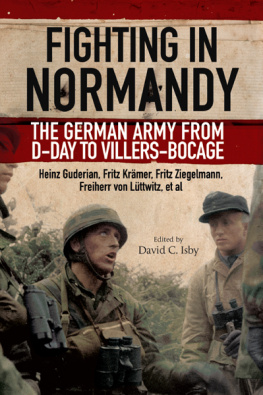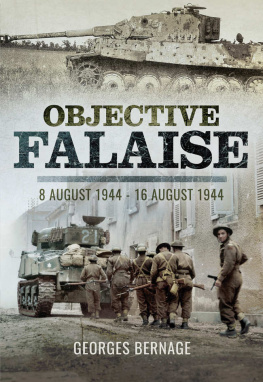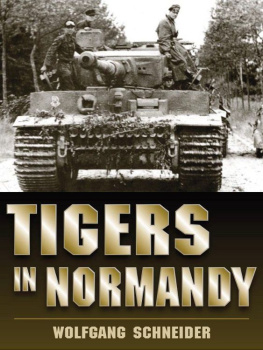Bernage - Battle of the Odon
Here you can read online Bernage - Battle of the Odon full text of the book (entire story) in english for free. Download pdf and epub, get meaning, cover and reviews about this ebook. year: 2017, publisher: Pen & Sword Books Ltd, genre: Non-fiction. Description of the work, (preface) as well as reviews are available. Best literature library LitArk.com created for fans of good reading and offers a wide selection of genres:
Romance novel
Science fiction
Adventure
Detective
Science
History
Home and family
Prose
Art
Politics
Computer
Non-fiction
Religion
Business
Children
Humor
Choose a favorite category and find really read worthwhile books. Enjoy immersion in the world of imagination, feel the emotions of the characters or learn something new for yourself, make an fascinating discovery.
- Book:Battle of the Odon
- Author:
- Publisher:Pen & Sword Books Ltd
- Genre:
- Year:2017
- Rating:5 / 5
- Favourites:Add to favourites
- Your mark:
- 100
- 1
- 2
- 3
- 4
- 5
Battle of the Odon: summary, description and annotation
We offer to read an annotation, description, summary or preface (depends on what the author of the book "Battle of the Odon" wrote himself). If you haven't found the necessary information about the book — write in the comments, we will try to find it.
Battle of the Odon — read online for free the complete book (whole text) full work
Below is the text of the book, divided by pages. System saving the place of the last page read, allows you to conveniently read the book "Battle of the Odon" online for free, without having to search again every time where you left off. Put a bookmark, and you can go to the page where you finished reading at any time.
Font size:
Interval:
Bookmark:

Battle of the Odon
GEORGES BERNAGE
Translated by Heather Williams

First published by Editions Heimdal in 2008 as La Bataille de lOdon
First published in Great Britain in 2017 by
Pen & Sword Military
An imprint of
Pen & Sword Books Ltd
47 Church Street
Barnsley
South Yorkshire
S70 2AS
Copyright Georges Bernage, 2017
ISBN 978 1 47385 761 2
eISBN 978 1 47385 860 2
Mobi ISBN 978 1 47385 859 6
The right of Georges Bernage to be identified as Author of this work has been asserted by him in accordance with the Copyright, Designs and Patents Act 1988.
A CIP catalogue record for this book is
available from the British Library.
All rights reserved. No part of this book may be reproduced or transmitted in any form or by any means, electronic or mechanical including photocopying, recording or by any information storage and retrieval system, without permission from the Publisher in writing.
Pen & Sword Books Ltd incorporates the Imprints of Pen & Sword Books Archaeology, Atlas, Aviation, Battleground, Discovery, Family History, History, Maritime, Military, Naval, Politics, Railways, Select, Transport, True Crime, Fiction, Frontline Books, Leo Cooper, Praetorian Press, Seaforth Publishing, Wharncliffe and White Owl.
For a complete list of Pen & Sword titles please contact
PEN & SWORD BOOKS LIMITED
47 Church Street, Barnsley, South Yorkshire, S70 2AS, England
E-mail:
Website: www.pen-and-sword.co.uk
The Battle of Normandy is one of the most famous campaigns in the Second World War, with the infamous D-Day landings, popularised by such films as The Longest Day , perhaps the most vivid in the general publics mind. While certainly not an historical document, the film has certainly made the events of this decisive day familiar to many. As well as 6 June 1944, there also exists a collective memory regarding the dramatic events surrounding the Falaise Pocket. However, the fighting that took place between 6 June and the end of the campaign was so difficult and intense, that at one point the American command believed the Allies would never escape from the bocage [farmland criss-crossed by dense hedgerows, trees and sunken roads, which is typically associated with the Normandy landscape]. Operation Epsom is emblematic of those first weeks, when the belief was that anything was possible and that victory could still be achieved swiftly.
In the days following the invasion, the Allies were in a race: their aim being to bring in more men and equipment than the Germans could supply reinforcements, not to mention the fact that the enemy were hampered by the incessant harassment of the allied invasion. The Americans quickly seized the Cotentin Peninsula, which constituted a large bridge-head, although at the same time, the British Second Army did not meet with similar success. By the evening of 6 June it had been halted in front of its primary objective, the city of Caen, and it would be another month before the city was finally taken. However, it is true that the US First Army had mainly come up against static infantry divisions, which were often of inferior quality, while in the British sector, two panzer divisions began to counter attack on 7 June: the 21. Panzer-Division and in particular the 12. SS-Panzer-Division Hitlerjugend , were elite fighting units that would soon demonstrate their outstanding military capabilities.
These two panzer divisions were quickly joined by another elite division, the Panzer-Lehr-Division, as well as the 2. Panzer-Division, which would arrive in the American sector. They were followed by a battalion of Tiger tanks, the s.SS-Panzer-Abteilung 101, which accidentally ended up blocking the British offensive at Villers-Bocage on 13 June. Montgomery was determined to re-launch the failed offensive and resolved to reach and then cross the Orne river and take Caen from the south. Decoded German messages revealed that reinforcements were due to arrive, including the II. SS-Panzerkorps, meaning that the Allies had to act quickly, and so Operation Epsom was born.
Three infantry divisions, an armoured division and two armoured brigades were sent to the left flank of the Hitlerjugend Division. The balance of power appeared to be crushingly in favour of the British and a swift victory seemed at hand. However, the soldiers of the Hiterjugend fought with an astonishing determination and the British soon fell behind: clearly, lessons from the earlier Blitzkrieg had not been learned. The offensive had been led by infantrymen carrying bayonets and guns, supported by tanks, just as they had been in 1918. General Roberts armoured division had to wait a day and a half before it was able to join in, which allowed the Germans to fall back to Hill 112 and halt the offensive, as well as allowing reinforcements to arrive. It was no longer simply an army corps (which involved around 80,000 men or even 100,000 if you include the 49th Division) against a German regiment, and now that the enemy had aligned its forces, the battle turned into a stalemate. Most of the units would fall back, in part, but Hill 112 would remain fiercely disputed until the end of the Battle of Normandy, after the Germans finally decided to withdraw.
Although the offensive was clearly a failure, it was later presented as being merely a feint: Montgomery had allegedly set a trap for the Germans whereby their panzers were drawn to the area around Caen, thus allowing the Americans an easier advance towards the west of Saint-L. Although this was undeniably a lie, it was true that General Montgomery was a proud man and it was this constant desire to beat his American allies in Europe that led to other failures. The first of these was the offensive at Villers-Bocage on 13 June, followed by Operation Epsom. Caen would eventually fall on 7 July, but only after considerable help from the Canadians. Operation Goodwood was another of Montgomerys failures, resulting in the loss of half of his tanks without any successful breakthrough, later followed by Operation Market Garden on 17 September, which ended in a humiliating retreat.
With Operation Epsom, Montgomery wanted a quick victory that involved crossing the Orne and capturing Caen. However, on 29 June his disappointment must have been as great as that of General OConnor [who was tasked with leading Operation Epsom] when he was forced to stop the offensive. The operation was not expected to fail, even though the terrain was unfavourable and the road network leading from north to south was inadequate (the main axis led from east to west), but progress had remained too slow, especially in such a narrow perimeter.
The area is now haunted by history and the local names resonate in French minds like the names of other famous battles in history: Fontenay, Tessel, Rauray, Saint-Manvieu, Cheux, Le Haut du Bosq, Brettevillette, Grainville, Colleville, Tourville, Mouen, Mondrainville, Tourmauville, Gavrus, Baron, Esquay and, of course, Hill 112. The terrain can be traversed easily and the distances between the various locations are short. I have visited the area often over the last thirty years, along with veterans who have shown me the places where they fought. What is striking is the density of the areas where action took place: something seemed to have happened every hundred metres, which the following pages will demonstrate. Once you have read this book, you can visit these places where history took place, and they will never leave you. At each junction, each hedge corner, you will discover the actors of this story, never forgetting, of course, that civilians also often found themselves caught up in the battle. Indeed, their losses were equal to those in the military: 20,000 civilians in Normandy lost their lives, which although a little less than those of the American soldiers, is certainly more than those in the British Army. The reconstructed houses serve as a reminder of the extent of the destruction. The village of Cheux, for example, was at the heart of the battle and fifteen of its inhabitants lost their lives.
Next pageFont size:
Interval:
Bookmark:
Similar books «Battle of the Odon»
Look at similar books to Battle of the Odon. We have selected literature similar in name and meaning in the hope of providing readers with more options to find new, interesting, not yet read works.
Discussion, reviews of the book Battle of the Odon and just readers' own opinions. Leave your comments, write what you think about the work, its meaning or the main characters. Specify what exactly you liked and what you didn't like, and why you think so.

